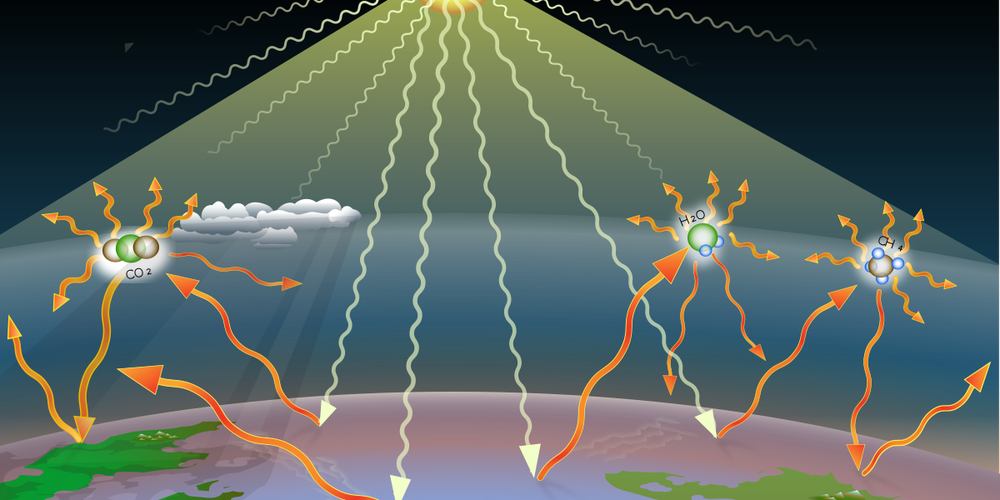#06: How does global warming work?

Everyone is talking about global warming and most people seem to have an opinion about it. But would you be able to explain how the basic processes of global warming work? And if you don't, is it still okay to ask? Yes, it is. This post gives a short explainer of the basic processes. Since we are all blessed with different attention spans, I'll have a go at different lengths of explanations.
First, the tl;dr (sorry, Boomer, this means "too long, didn't read"):
Earth receives light energy from the sun (white lines in the image at the top of the page), and releases large parts of it again as infrared light (orange lines). Greenhouse gases (like CO2 and methane) hinder this release by trapping the energy in the atmosphere, thus heating it up.

Wow, that was a really short one. And as so often, when you try to keep something really short, important aspects may fall short or be misunderstood. So secondly, let me point you to the marvellous page How Global Warming Works, which offers brief explanations of global warming for non-scientists in word and video. You can choose if you want to watch the quick version (52 seconds), the longer version (5 minutes), or intermediates.
Thirdly, you also don't want to miss out on this good explainer by Dr. Kevin Cowtan from the University of York:
And finally, after all these videos you probably want to read some plain interesting words, right? Then please read how Prof. Michael Ranney, Dr. Daniel Reinholz, and Dr. Lloyd Goldwasser have eloquently put it together:
"First, here is how Earth’s temperature works without considering how humans influence it: The Earth absorbs light from the sun, which is mostly visible light. To release that light-energy, Earth also emits light. But because the Earth is cooler than the sun, it emits lower-energy, infrared light. So Earth's surface essentially transforms most of the visible light it gets from the sun into infrared light. Greenhouse gases in the atmosphere, such as methane and carbon dioxide, let visible light pass through, but absorb infrared light - causing the atmosphere to retain heat. This energy can be absorbed and emitted by the atmosphere many times before it eventually returns to outer space. The added time this energy hangs around has helped keep Earth warm enough to support life as we know it. Without this “greenhouse effect” - caused by these greenhouse gases in the atmosphere - the Earth’s average surface temperature would be about 50 degrees Fahrenheit cooler, which is well below the freezing point for ice!
So, how have humans changed things? Since the dawn of the industrial age, around the year 1750, atmospheric carbon dioxide has increased by 40% - and methane has almost tripled! These increases cause extra infrared light absorption, meaning an extra greenhouse effect, which has caused Earth to heat above its typical temperature range. In other words, energy that gets to Earth has an even harder time leaving it, causing Earth’s average temperature to increase - thus producing global climate change."
See? That was not very hard to understand, and as mentioned before, this basic effect is known for two hundred years (although details may have been found later). But I want to point out that this is a simplification of the process. There are so many details regarding, e.g., the reflection of sun light on different surfaces of the earth (water, snow, and soil of course have different reflection rates, aka "albedos"), the length and warmth of days and nights, or the role that clouds play in the process (positive AND negative feedback mechanisms), just to name a few. While it is important to understand these details in order to analyse the magnitude of global warming, it is sufficient for this blog to get the gist of the basic processes. Because even these basics are being attacked and disputed by climate science deniers (not to speak of the details, mind you). And to many people it is still unclear how grounded and settled our understanding of the greenhouse effect is.

A friend once told me that he is understanding that climate change is happening and that he "mostly agrees" that humans seem to be responsible for it. But (there is always a but) he disagrees that our government should introduce regulations on the basis of a dogma such as the greenhouse effect. And this is basically what some kind of media outlets are proclaiming: That the greenhouse effect is a dogma. Just to remind you of the definition of this word: "In the pejorative sense, dogma refers to enforced decisions, such as those of aggressive political interests or authorities (Source: Merriam Webster). More generally, it is applied to some strong belief whose adherents are not willing to discuss rationally." So for one they say that a dogma is a "decision" made and secondly, the adherents of this "belief" are not willing to discuss it. That is how the greenhouse effect is displayed by malicious sources. But as explained at the top, the greenhouse effect is not a dogma, but a scientific finding. As such, it is always open for discussion and it can be challenged for its validity as soon as new evidence is presented that corrects our previous understanding of it. However, this has not happened since its first discovery in the beginning of the 19th century (see blog post #04 for details).
Finally, for my German readers (yes, I know there are some), I want to provide this nice explainer by Michael Flammer, a representative of the remarkable #klimaVor8 initiative, which I do hold dear.




